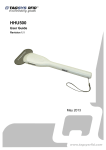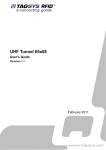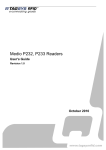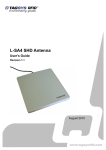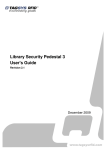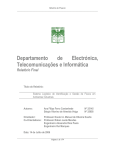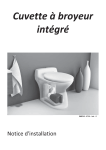Download Medio P213 - User Guide v1-0
Transcript
Medio P213 Reader User's Guide Revision 1.0 October 2010 Medio P213 Reader User's Guide Publishing Information Disclaimer and Limitation of Liability All information herein is either public information or is the property of and owned solely by TAGSYS who shall have and keep the sole right to file patent applications or any other kind of intellectual property protection in connection with such information. Nothing herein shall be construed as implying or granting to you any rights, by license, grant or otherwise, under any intellectual and/or industrial property rights of or concerning any of TAGSYS’ information. This document can be used for informational, non-commercial, internal and personal use only provided that: ♣ The copyright notice below, the confidentiality and proprietary legend and this full warning notice appear in all copies. ♣ This document shall not be posted on any network computer or broadcast in any media and no modification of any part of this document shall be made. Use for any other purpose is expressly prohibited and may result in severe civil and criminal liabilities. The information contained in this document is provided “AS IS” without any warranty of any kind. Unless otherwise expressly agreed in writing, TAGSYS makes no warranty as to the value or accuracy of information contained herein. The document could include technical inaccuracies or typographical errors. Changes are periodically added to the information herein. Furthermore, TAGSYS reserves the right to make any change or improvement in the specifications data, information, and the like described herein, at any time. Therefore TAGSYS assumes no liability and is not responsible for customer applications or product or software which include TAGSYS products. TAGSYS HEREBY DISCLAIMS ALL WARRANTIES AND CONDITIONS WITH REGARD TO THE INFORMATION CONTAINED HEREIN, INCLUDING ALL IMPLIED WARRANTIES OF MERCHANTABILITY, FITNESS FOR A PARTICULAR PURPOSE, TITLE AND NON-INFRINGEMENT. IN NO EVENT SHALL TAGSYS BE LIABLE, WHETHER IN CONTRACT, TORT OR OTHERWISE, FOR ANY INDIRECT, SPECIAL OR CONSEQUENTIAL DAMAGES OR ANY DAMAGES WHATSOEVER INCLUDING BUT NOT LIMITED TO DAMAGES RESULTING FROM LOSS OF USE, DATA, PROFITS, REVENUES, OR CUSTOMERS, ARISING OUT OF OR IN CONNECTION WITH THE USE OR PERFORMANCE OF INFORMATION CONTAINED IN THIS DOCUMENT. TAGSYS does not and shall not warrant that this product/system/equipment will be resistant to all possible attacks, and shall not incur, and disclaims, any liability in this respect. Even if each product is compliant with current security standards in force on the date of their design, security mechanisms' resistance necessarily evolves according to the state-of-the-art in security and notably under the emergence of new attacks. Under no circumstances shall TAGSYS be held liable for any third party actions, and in particular in case of any successful attack against systems or equipment incorporating TAGSYS products. TAGSYS disclaims any liability with respect to security for direct, indirect, incidental or consequential damages that result from any use of its products. It is further stressed that independent testing and verification by the person using the product is particularly encouraged, especially in any application in which defective, incorrect, or insecure functioning could result in damage to persons or property, denial of service, or loss of privacy. © 2000-2010 TAGSYS. All rights reserved. Microsoft, Visual C++, Windows, and Windows NT are either registered trademarks or trademarks of Microsoft Corporation in the U.S.A. and/or other countries. I-Code is a registered trademark of Philips. Tag-It is a registered trademark of Texas Instruments. Printed in France. TAGSYS – 785 Voie Antiope, Athélia III, 13600 La Ciotat, France. Tel: +33 (0) 4.42.18.89.00 / Fax: +33 (0) 4.42.18.89.01 Document Reference: DOC14227A0 2/34 Revision 1.0 October 2010 Medio P213 Reader User's Guide Read This First Welcome to the TAGSYS range of products operating at the 13.56 MHz frequency. This range of products is used to implement high-quality RFID systems for demanding applications. This document provides information about how to install and use Medium Range Medio P213 TAGSYS RFID Tag Readers. Audience This document requires familiarity with RFID technology. It is intended for people in charge of installing and using the product. Conventions Symbol Meaning CAUTION: A note that advises users that a specific action could result in the loss of data or damage the hardware. WARNING: A note that advises users that a specific action may result in physical harm. A note that provides additional information that helps the user to perform a task or obtain the best performance from the product. If you need assistance Please contact your nearest TAGSYS sales representative or the TAGSYS welcome desk at: Telephone: Fax: E-Mail: +33 (0) 4 42 18 89 00 +33 (0) 4 42 18 89 01 [email protected] Website http://www.tagsysrfid.com Contact for Comments We welcome your feedback to help us provide high quality documentation. For technical comments, please contact our welcome desk: Telephone: Fax: E-Mail: +33 (0) 4 42 18 89 00 +33 (0) 4 42 18 89 01 [email protected] Please remember to quote the Document Reference Number DOC14227A0, your job title and your company. October 2010 Revision 1.0 3/34 Medio P213 Reader User's Guide Quality Issues TAGSYS implements stringent quality controls at all stages of its manufacturing process. However, should you find a defect with this product, please notify your TAGSYS Quality Service representative using the dedicated Product Return Form. Telephone: Fax: +33 (0) 4 42 18 89 36 +33 (0) 4 42 18 89 01 RoHS and WEEE Directives RoHS (Restriction of the uses of certain Hazardous Substances) TAGSYS certifies that this product is compliant with the European Directive 2002/95/EC for the restriction in Electric and Electronic Equipments (RoHS) of the use of the following hazardous substances: • Lead • Mercury • Cadmium • Hexavalent Chromium • Polybrominated biphenyl flame retardants • Polybrominated diphenyl ether flame retardants This declaration is based on information provided by our suppliers and subcontractors. WEEE (Waste Electrical and Electronic Equipment) This product bears the selective sorting symbol for waste electrical and electronic equipment (WEEE) This means that this product must be handled pursuant to European Directive 2002/96/EC in order to be recycled or dismantled to minimize its impact on the environment. For further information, please contact your local or regional authorities. 4/34 Revision 1.0 October 2010 Medio P213 Reader User's Guide Table of Contents PUBLISHING INFORMATION __________________________________________________________ 2 DISCLAIMER AND LIMITATION OF LIABILITY __________________________________________________ 2 READ THIS FIRST ____________________________________________________________________ 3 AUDIENCE ____________________________________________________________________________ 3 CONVENTIONS _________________________________________________________________________ 3 IF YOU NEED ASSISTANCE ________________________________________________________________ 3 CONTACT FOR COMMENTS _______________________________________________________________ 3 QUALITY ISSUES _______________________________________________________________________ 4 ROHS AND WEEE DIRECTIVES ___________________________________________________________ 4 ROHS (RESTRICTION OF THE USES OF CERTAIN HAZARDOUS SUBSTANCES) ______________________ 4 WEEE (W ASTE ELECTRICAL AND ELECTRONIC EQUIPMENT) ___________________________________ 4 1 1.1 1.2 1.3 1.4 2 INTRODUCTION ___________________________________________________________________ 7 GENERAL ________________________________________________________________________ 7 PRODUCT DESCRIPTION ____________________________________________________________ 7 KEY FEATURES____________________________________________________________________ 8 DELIVERY ________________________________________________________________________ 8 FUNCTIONAL OVERVIEW __________________________________________________________ 9 2.1 FUNCTIONAL BLOCK DIAGRAM _______________________________________________________ 9 2.2 COMMUNICATION PROTOCOLS ______________________________________________________ 10 2.2.1 TAG-TO-READER INTERFACE ______________________________________________________ 10 2.2.2 READER-TO-HOST INTERFACE _____________________________________________________ 10 2.3 PERIPHERAL DEVICES _____________________________________________________________ 10 3 INSTALLING THE READER________________________________________________________ 11 3.1 PIN CONNECTIONS ________________________________________________________________ 11 3.2 POWER SUPPLY __________________________________________________________________ 12 3.3 ANTENNA _______________________________________________________________________ 12 4 SERIAL COMMUNICATION LINKS _________________________________________________ 13 4.1 GENERAL INFORMATION ON DATA ACQUISITION ________________________________________ 13 4.2 RS-232 INTERFACE _______________________________________________________________ 14 4.2.1 INSTALLING THE READER IN RS-232 MODE ___________________________________________ 14 4.2.2 SETTING THE HOST SYSTEM RS-232 COMMUNICATION LINK ____________________________ 14 4.2.3 ELECTRICAL SIGNAL REQUIREMENTS _______________________________________________ 15 4.3 RS-422 / RS-485 INTERFACE _______________________________________________________ 15 4.3.1 INSTALLING THE RS-422 INTERFACE ________________________________________________ 15 4.3.2 INSTALLING THE RS-485 FULL DUPLEX INTERFACE ____________________________________ 16 4.3.3 INSTALLING THE RS-485 HALF DUPLEX INTERFACE ____________________________________ 17 4.3.4 GROUNDING ARRANGEMENT ______________________________________________________ 18 October 2010 Revision 1.0 5/34 Medio P213 Reader User's Guide 4.3.5 ELECTRICAL SIGNAL REQUIREMENTS _______________________________________________ 19 5 CONNECTING PERIPHERAL DEVICES _____________________________________________ 20 5.1 USING THE UNIVERSAL INPUT PIN ____________________________________________________ 20 5.2 USING THE UNIVERSAL OUTPUT PIN __________________________________________________ 20 5.3 I/O ELECTRICAL SIGNAL REQUIREMENTS _____________________________________________ 22 6 STAND-ALONE MODE ____________________________________________________________ 23 6.1 STAND-ALONE MODE FEATURES ____________________________________________________ 23 6.1.1 CUSTOMIZED TAG TYPE READING __________________________________________________ 23 6.1.2 SERIAL COMMUNICATION TYPE ____________________________________________________ 24 6.1.3 CUSTOMIZED ASCII MESSAGE FORMAT _____________________________________________ 24 6.1.4 REPETITION OPTION _____________________________________________________________ 24 6.1.5 TRIGGER INPUT _________________________________________________________________ 25 6.1.6 OUTPUT SETTINGS ______________________________________________________________ 25 6.2 ENABLING STAND-ALONE MODE ____________________________________________________ 25 6.3 DISABLING STAND-ALONE MODE ____________________________________________________ 25 7 TECHNICAL SPECIFICATIONS ____________________________________________________ 26 7.1 MEDIO P213 TECHNICAL SPECIFICATIONS ____________________________________________ 26 8 MECHANICAL CHARACTERISTICS ________________________________________________ 27 8.1 DIMENSIONS AND GENERAL MECHANICAL INFORMATION_________________________________ 27 8.2 MARKINGS ______________________________________________________________________ 27 9 ELECTRICAL CHARACTERISTICS _________________________________________________ 28 9.1 9.2 9.3 9.4 9.5 ABSOLUTE MAXIMUM RATINGS ______________________________________________________ 28 POWER SUPPLY DC CHARACTERISTICS ______________________________________________ 29 COMMUNICATION LINK DC CHARACTERISTICS AND TIMINGS ______________________________ 30 ANTENNA ELECTRICAL AND TIMING CHARACTERISTICS __________________________________ 31 I/O ELECTRICAL CHARACTERISTICS __________________________________________________ 31 10 WARRANTY CONDITIONS _______________________________________________________ 32 10.1 WARRANTY _____________________________________________________________________ 32 10.2 WARRANTY EXCLUSIONS _________________________________________________________ 32 10.2.1 GENERAL PROVISIONS __________________________________________________________ 33 10.2.2 HOW TO RETURN DEFECTIVE PRODUCTS ___________________________________________ 33 6/34 Revision 1.0 October 2010 Medio P213 Reader User's Guide 1 Introduction 1.1 General This document provides information about how to install and use the Medium Range Medio P213 TAGSYS RFID Tag Reader. 1.2 Product Description TAGSYS Medio P213 RFID Tag Reader is intended for Original Equipment Manufacturer (OEM) applications. The Medio P213 is Medium Range 13.56 MHz RFID reader designed to operate with any TAGSYS RFID Tag using C210, C240, C270, C370, C370-L/S and ISO15693 chips. Medio P213 reader requires minimal computing power from the host workstation (Windows®based PC or UNIX environment). It communicates easily with this host at a high speed, using the simple TAGSYS enhanced communication protocol (STX-E). Figure 1: Medio P213 TAGSYS RFID Tag Reader Application Overview The Medio P213 TAGSYS RFID Tag readers are easy to integrate because of its: • • small size standard communication links October 2010 Revision 1.0 7/34 Medio P213 Reader User's Guide 1.3 Key Features Table 1: Medio P213 Key Features Description Medio P213 Operating Frequency 13.56 MHz Compatibility C210, C240, C270, C370, C370-L/S, ISO15693 chips Stand-alone Mode C210, C240, C270, C370, C370-L/S, ISO 15693 chips Selectable Serial Link RS-232, RS-422, RS-485 (Half or Full duplex) Network Operating Yes I/Os 1 input and 1 output Firmware upgradeable Yes 1.4 Delivery The Medio P213 TAGSYS RFID Tag Reader kit contains the following items: Table 2: Package Contents Quantity Item 1 Medio P213 TAGSYS RFID Tag Reader 1 SMA/BNC Adaptor 4 Configuration jumpers 1 CD-ROM including: 1 8/34 • Medio P213 Integrator's Guide • Medio P200u/s, P213, P232/3 Command Set • User-friendly Px Explorer software provided for test and debug operations on Windows XP, 200x, Vista and Seven platforms • Tagsys Legacy Software Development Kit including o DLLs and ActiveX o Library Software Development Kit Documentation o One set of source code and executable samples • Tagsys Universal Software Development Kit including o Native DLL o .NET Component o One set of source code and executable samples Welcome Letter / Product Return Form Revision 1.0 October 2010 Medio P213 Reader User's Guide 2 Functional Overview This section provides an overview of the architectural structure and peripheral devices of the Medio P213 TAGSYS RFID Tag Reader. It also provides a summary of the special functions used to drive the reader board and describes the automatic features managed by the Central Processing Unit (CPU). 2.1 Functional Block Diagram The Medio P213 architectural structure is based on a CPU that drives all reader functions. It manages communications between the host system (connected to the “Reader-to-Host interface”) and one or more TAGSYS RFID Tags using an antenna (connected to the “Tag-toReader interface”). It also drives 1 Universal Input and 1 Universal Outputs. Figure 2 illustrates the general architecture of Medio P213 TAGSYS RFID Tag Reader. Figure 2: Overall Medio P213 Architecture Periphe ra l Devices Power Suppl y Powe r Supply Opera ti ng Mode Host Conne ction s R S-2 32 R S-4 22 R S-4 85 October 2010 Re ade rto-Host Inter face Stand-alone Normal 1 Input and 1 Output Interfac e Central Pr oce ssing Unit Medio P213 TAGSYS RFID Ta g Reader Tag-toReaderInterface Antenn a AS CII Protocol S TX -E Decoder/ Encoder Revision 1.0 9/34 Medio P213 Reader User's Guide 2.2 Communication Protocols 2.2.1 Tag-to-Reader Interface To read from TAGSYS RFID Tags, to write to their memory, or to activate their functions, a wide command set is available. For a complete list of embedded commands and their description, please refer to the Medio P213 Command Set document. 2.2.2 Reader-to-Host Interface When the Medio P213 reader is connected to an antenna, it acts more as a protocol converter due to the wide range of tasks it can perform. For more information about these tasks, refer to the Medio P213 Command Set document. Depending on the task requested by the user through the host interface, the reader retrieves information from the TAGSYS RFID Tag or provides it with information using its own communication protocol. The reader then converts the result of the operation into STX-E protocol and returns the information to the host via the Reader-to-Host interface. For more information, refer to the Medio P213 Command Set document. The Reader-to-Host interface has two operating modes: 1. Normal Mode The Reader-to-Host interface is the slave of the master host system. It waits for a valid command from the host, performs the task and responds. This bi-directional communication is achieved via the STX-E protocol. (For more information, please refer to the Medio P213 Command Set document.) 2. Stand-alone Mode The Reader-to-Host interface is independent from the host system. Stand-alone mode is used by the Medio P213 reader to read tags and send their identification data to the host system. This transmission takes place in ASCII format. While in this mode, the reader cannot receive any commands. For more information, please refer to Section 7, “Stand-alone Mode”. 2.3 Peripheral Devices The I/O interface manages 1 input and 1 output that can drive or check external peripherals. The input is compliant with open collector drivers, TTL/CMOS voltage levels and industrial levels (up to 25V). The output consists of a gate controlled MOSFET transistor driver that can drive up to 1.5A. It is safe from current and thermal overloads. +5V current limited option is available to give TTL/CMOS compliant levels. The I/O pins are mainly used for static applications such as reading sensors or driving LEDs, relays or buzzers. For more information, refer to Section 6.1 “Using the Universal Input pin” and Section 6.2 “Using the Universal Output pin”. 10/34 Revision 1.0 October 2010 Medio P213 Reader User's Guide 3 Installing the Reader This section explains how best to install the Medio P213 TAGSYS RFID Tag Reader board. The physical description of the reader board is given in Section 9, “Mechanical Characteristics”. 3.1 Pin Connections Connection System Communication connector J1A : Sub-D9 Male #2 : Data transmitted to the reader for RS232 Mode (TD signal for PC) RX+ signal for RS422 or RS485 mode #3 : Data sent by the reader for RS232 mode (RD signal for PC) TX+ signal for RS422 or RS485 mode #5 : Ground #6 : RX- signal for RS422 or RS485 mode #9 : TX- signal for RS422 or RS485 mode All other pins are not connected. Power supply connector J2A : 2.5mm Jack type (positive connection on the center pin) IO Connector J3 : Industrial terminal block (screw connections) #1 : Configurable supply output #2 : High power output #3 : Ground for output #4 : Universal input October 2010 Revision 1.0 11/34 Medio P213 Reader User's Guide #5 : Ground for input Programmation Connector J4 : HE10 type RF antenna connector J5 : 3.2 SMA type Power Supply A DC power supply must be connected to J2 connector and must be able to withstand a peak current of 600 mA (for 10V supply) when the reader is powered on. Please refer to Section 10, “Electrical Characteristics” for more details about reader consumption. The power pins accept an input voltage between 10 and 24 V DC. 3.3 Antenna The J5 connector is dedicated to an antenna that is required for reading TAGSYS RFID Tags. This can be a TAGSYS antenna or a custom-made model. The choice of the antenna must take into account the following considerations: • • • Physical area (size) of the TAGSYS RFID Tag Strength of the reader Compliance with electrical characteristics (see Electrical Characteristics chapter) The antenna has a passive design that features 50 ohm, 0° impedance characteristics at 13.56 MHz frequency. 12/34 Revision 1.0 October 2010 Medio P213 Reader User's Guide 4 Serial Communication Links Medio P213 TAGSYS RFID Tag Readers are based on a Master-Slave communication system where the host system acts as the master and the reader as the slave. In Stand-alone mode, the reader is used as a master and the host system becomes the slave. The Host-to-Reader interface accepts an RS-232, RS-422 or RS-485 (Full or Half Duplex) communication links. The communication type is selected using the jumpers on the Serial communication selector : J4 J3 RS232 Mode RS422 Mode RS485 Mode 4.1 General Information on Data Acquisition Communication takes place by sending frames (bytes) on the communication link. The bytes are transmitted LSB first with one start bit and one stop bit as shown in Figure 3. Figure 3: Structure of a Byte on the Communication Link 1 Start Bit October 2010 LSB MSB 8 bits with LSB First Revision 1.0 0 Stop Bit 13/34 Medio P213 Reader User's Guide Communication parameters are listed in Table 3. These parameters cannot be modified. Table 3: Parameters for the Transmission of a Byte Parameter Value Allowed Baud Rate 4800, 9600, 19200, 38400, 57600 or 115200 bps (depending on the reader settings) Default Baud Rate 38400 Start Bit On Number of data bits 8 Parity None Stop bit 1 The maximum period between the transmission of bytes is 10 ms, regardless of the applicable baud rate. 4.2 RS-232 Interface 4.2.1 Installing the reader in RS-232 mode To use the RS-232 interface, you can connect a NULL-MODEM RS232 cable to the suitable COM port of a PC. Please configure the Serial Communication Selector as shown in Chapter 5. 4.2.2 Setting the Host System RS-232 Communication Link The host system RS-232 communication link must be set as shown in Table 4. Table 4: RS-232 Allowed Settings on the Host System Parameter Value Baud Rate Accordingly to the reader Baud Rate Configuration Start bit On Number of data bits 8 Parity None Stop bit 1 Data flow None 14/34 Revision 1.0 October 2010 Medio P213 Reader User's Guide 4.2.3 Electrical Signal Requirements Table 5 shows the electrical characteristics of the RS-232 interface pins. Table 5: RS-232 Interface Pins - Electrical Characteristics Parameters Conditions RS232 Input Voltage Range Min. -25 RS232 Input Voltage Low 25°C RS232 Input Voltage High 25°C Unit +25 V 0.8 V V 0.6 RS232 Input Resistance Loaded with 3 kΩ RS232 Output Short-circuit current 4.3 Max. 2 RS232 Input Hysteresis RS232 Output Voltage Swing Typ. V 3 5 ±5 ±6.5 V ±60 mA 7 kΩ RS-422 / RS-485 Interface The RS-422 interface is compatible with EIA/TIA-422 standards. The RS-485 interface is compatible with EIA/TIA-485 standards. The RS-485 permits a balanced transmission line to be shared in Party Line or Multi-drop mode. As many as 32 receiver (readers or repeaters) pairs can share a Multi-drop network. If more readers are needed in the network, balanced line repeaters can be used (a repeater takes the place of a reader on the network). 4.3.1 Installing the RS-422 Interface Figure 4 shows how to connect the RS-422 interface. The balanced line RX+ and RX- corresponds to the reader receiver and must be connected to the transmitter of the host. The balanced line TX+ and TX- corresponds to the reader transceiver and must be connected to the receiver of the host. A 120-Ohm resistor should be added at the end of a transmission line in compliance with RS-422 specifications. This resistor can be connected by connecting a jumper on the RS422 Terminaison selector. When set to communicate according to RS-422 specifications, the reader always holds its transceiver active and never switches it into Tri-state mode. The Host-to-Reader Interface should not be unplugged. October 2010 Revision 1.0 15/34 Medio P213 Reader User's Guide Figure 4: Connection of the RS-422 Interface TX+ RX+ R TX- RX- RX+ TX+ R RX- TX- Host To Reader Interface Host RS-422 Interface Reader 4.3.2 Installing the RS-485 Full Duplex Interface The RS-485 Full Duplex Standard requires 2 pairs of balanced lines, one for transmitting and another for receiving data. When testing your network installation, make sure that all the connected readers are : - correctly supplied - correctly configured (Communication link selector and Terminaison resistor) - correctly connected (cable connections) If one reader is faulty on the network, all the network may be mute to any command sent over the network. Make sure that all the readers are preset with a different network address to avoid network conflicts. By default, a Medio P213 is preset with address 0. 16/34 Revision 1.0 October 2010 Medio P213 Reader User's Guide Figure 5: Connection of the RS-485 Full Duplex Interface TX+ R TX- RX+ R RX- Host RS-485 Full Duplex Interface RX+ RX- TX+ TX- RX+ RX- TX+ TX- Host To Reader Interface Host To Reader Interface Reader 1 Reader n Figure 5 shows how to connect the RS-485 Full Duplex Interface in a Multi-drop network. The balanced line TX+ and TX- corresponds to the reader transceiver and must be connected to the receiver of the host (and other reader transceivers or repeater). A 120-Ohm resistor should be added at the end of the two transmission lines in compliance with RS-485 specifications. This resistor can be connected by connecting a jumper on the RS422/RS485 Termination Selector on the end-line reader. When set to communicate using the RS-485 interface, the reader always holds the transmission lines before the start of any communication and returns to Tri-state mode at the end of communication. The host system should do the same. The reader can be unplugged from the balanced lines. 4.3.3 Installing the RS-485 Half Duplex Interface RS-485 Half Duplex Standard requires only 1 pair of balanced lines, for both transmitting and receiving data. October 2010 Revision 1.0 17/34 Medio P213 Reader User's Guide When testing your network installation, make sure that all the connected readers are : - correctly supplied - correctly configured (Communication link selector and Termination resistor) - correctly connected (cable connections) If one reader is faulty on the network, all the network may be mute to any command sent over the network. Make sure that all the readers are preset with a different network address to avoid network conflicts. By default, a Medio P213 is preset with address 0. The balanced line TX+ and TX- corresponds to the reader driver and must be connected to the driver of the host (and other reader drivers or repeater). The RS-485 Half Duplex interface is configured by setting the reader in RS-485 Full Duplex mode and connecting pins RX+ and RX- to pins TX+ and TX- pins respectively on each reader of a network. Figure 6 shows how to connect the RS-485 Half Duplex Interface in a multi-drop network. Figure 6: Connection of the RS-485 Half Duplex Interface R R D+ D- RX+ RX- TX+ TX- RX+ RX- 4.3.4 TX+ TX- Host RS-485 Half Duplex Interface Host To Reader Interface Host To Reader Interface Reader 1 Reader n Grounding Arrangement In order for the generator and the receiver to operate correctly, a signal return path must exist between the reader grounds of the equipment at each end of the interconnection. The reader reference may be established by a third conductor connecting the common leads of the devices, or it may be provided by the connection from each equipment item to a ground reference. Where the reader reference is provided by a third conductor, the connection between the reader common and the third conductor must contain a certain amount of resistance (e.g. 100 ohms) to limit circulating currents when other ground connections are provided for safety. 18/34 Revision 1.0 October 2010 Medio P213 Reader User's Guide Figure 7: Grounding Arrangement for RS-422 / RS-485 Third Conductor Rg' Rg' Host System MEDIO P013 GND GND Rg Rg Use Rg or Rg' resistors Chassis Reference Earth (safety) Reference 4.3.5 Electrical Signal Requirements The following table shows the electrical characteristics of the RS-422/RS-485 interface pins. Table 6: RS-422/ RS-485 Interface Pins - Electrical Characteristics Parameters Receiver Input Resistance Receiver Input Current Conditions -7V < VCM < +12V Min. Typ. 12 24 VCM = +12V VCM = -7V Receiver Input Differential Threshold 2 6 RS-485 1.5 6 -0.2 +0.2 ±250 ±5 Revision 1.0 mV mV RS-422 Output Leakage Current October 2010 200 40 Transceiver Output Short-circuit Current mA -0.8 -200 Change In Magnitude of Transceiver Differential Output Voltage for Complementary Output States Unit kΩ 1 Receiver Input Hysteresis Transceiver Differential Output Voltage Max. V V mA 500 µA 19/34 Medio P213 Reader User's Guide 5 Connecting Peripheral Devices 5.1 Using the Universal Input pin The reader input can be driven by a voltage source from 0V up to 24V referring to the input ground. A relay (open chain transistor, switch…) can also be used to connect the input pin and its ground. - Low level input voltage is defined to be in the range of 0 to 1.5V - High level input voltage is defined to be in the range of 3 to 25V 5.2 Using the Universal Output pin The output pin is an open drain power transistor that can drive a current up to 1.5A. When activated, the power transistor connects the output pin and its ground. The output transistor is protected against heating and current overload. If an overload happens, the output stops driving current automatically. The output must be turned off to be re-activated. You can use the Configurable Supply Output pin of the IO connector to deliver a supply to an active system connected to the output. You can set it to deliver the supply used to power the reader or a +5V supply limited by a 470 Ohms serial resistor by using the Supply Output Pin Selector with a jumper. +5V Supply Output J3 Reader power supply Output When the output is activated by the reader, a green led near the IO connector turns on. Beware that the LED will stay on while the output is in thermal or current overload state. The figure above describes the output architecture: Output supply jumper selector Main power supply 5VDC J3-1 470 Ώ J3-2 J3-3 20/34 Revision 1.0 October 2010 Medio P213 Reader User's Guide Example 1 : Connecting a LED to the Output The LED’s cathode is connected to the Output pin and its anode to the Output Supply Pin. Note that the Output supply jumper selector is configured to deliver 5V to supply the LED. The internal serial resistor limits the current delivered to the LED. Example 2 : Connecting a Lamp (5W under 24 V) to the Output using the reader supply The common wire (-) of the lamp is connected to the Output pin (J3-2) and its supply to the Output Supply Pin (J3-1). Note that the Output supply selector is configured to deliver the Power of the reader to the lamp. The lamp needs a 24V power supply, so the reader is supplied with 24V. The consumption of the lamp is less than 1 Ampere, so it can be connected directly to the reader output. October 2010 Revision 1.0 21/34 Medio P213 Reader User's Guide 5.3 I/O Electrical Signal Requirements Table 7 provides the electrical DC characteristics. Table 7: I/O Interface Pins - Electrical Characteristics Parameters Conditions Min. Typ. Max. Unit Input Voltage Low 0 2 V Input Voltage High 3 25 V 1.5 A Output Current 22/34 Revision 1.0 Note October 2010 Medio P213 Reader User's Guide 6 Stand-alone Mode Stand-alone Mode is designed to use the reader without using any command set. While in this mode, the reader is limited to tag reading. The reader sends the tag ID to the Host System using ASCII protocol via the Reader-to-Host interface. ASCII protocol is used in order to provide hexadecimal data that can be read by a variety of terminal programs (e.g. Microsoft® HyperTerminal). 6.1 Stand-alone Mode Features Table 8 lists the available features for each TAGSYS RFID Tag reader in Stand-alone mode. Table 8: Available Features in Stand-alone Mode Features Medio P213 Customized tag type reading C210 C240 C270 (Philips I.Code) ISO 15693 Serial Communication Type RS-232 RS-422 Baud Rate 4800, 9600, 19200, 38400, 57600, 115200 bps Repetition Option Available Customized ASCII message format STX/ETX Characters Header String Chip Description String ID String (variable length) End of Message String Input Trigger Available Output for active trigger information Available Output for tag reading information Available 6.1.1 Customized Tag Type Reading When using Medio P213 readers, tags to be scanned can be configured using the “Set Standalone Mode” command. For more information, refer to the Medio P213 Command Set document. October 2010 Revision 1.0 23/34 Medio P213 Reader User's Guide 6.1.2 Serial Communication Type When used in Stand-alone mode, Medio P213 readers can communicate via the RS-232, RS-422 or RS-485 link types. Stand-alone is not recommended in a network configuration. 6.1.3 Customized ASCII Message Format When a TAGSYS RFID Tag is read, its data is transmitted to the host in the form of an ASCII character frame. Optional Optional 2 to 16 characters C240 2 to 16 characters C270 2 to 16 characters ISO15693 2 to 16 characters Required End of Message String End of Text <ETX> (0x03) 1 character Optional C210 <CR/LF> (Default) 0 to 16 characters ID Chip Description String 0 to 16 characters Medio P213 “TAGSYS-“ Chip name (Default) 0 to 16 characters Size <STX> (0x02) 1 character Description Header String Start of Text Table 9: Customized ASCII Message Format (TAGSYS RFID Tag is read) Optional Optional Medio P213 readers can decode all chips in Standalone mode. Only the ID field is required in the return ASCII message. All other fields are optional. The ID field length is programmable, the default lengths are given in Table 10. Table 10: Default ID Field Lengths 6.1.4 Chip Type Default ID Field Length C210 chip 16 (Total memory) C240 chip 16 (Block 0 Page 0) C270 chip 16 (Block 0 and Block 1) ISO15693 chip 16 (UID) Repetition Option The reader constantly attempts to read any chips present in the field. When a chip ID is detected, the reader can send the information to the host in one of 2 modes: 1. In “Repeated Read” mode, the reader returns a chip’s ID to the host with each successful read operation. 2. In “Read Once” mode, the reader only returns the ID of a chip if the previous read corresponds to a different chip, or if all reading attempts have failed 4 times (this feature makes it possible to detect a chip’s potential exit out of the field). 24/34 Revision 1.0 October 2010 Medio P213 Reader User's Guide 6.1.5 Trigger Input When the trigger capability is enabled, a trigger state is used to start and stop the RF scanning. The trigger is connected to the input of the reader. Depending on the reply settings of the trigger, the ASCII message can be sent during the trigger activity (Repeated Read mode and Read Once mode are available) or at the end of the trigger. In this last case, a message is always sent to the host system: ♣ if a tag has been read, the message contains its ID, ♣ if a tag has not been read, the message contains a No Message string (that can be defined) as shown in Table 11. Table 11: Customized ASCII Message Format (TAGSYS RFID Tag is not read) Start of Text Header String No Tag Found String End of Message String End of Text Description <STX> (0x02) “TAGSYS-“ (Default) “????????“ (Default) <CR/LF> (Default) <ETX> (0x03) Size 1 character 0 to 16 characters 0 to 16 characters 0 to 16 characters 1 character Medio P213 Optional Optional Required Optional Optional 6.1.6 Output Settings The output of the reader can be used to monitor the trigger activity or the successful reads. 6.2 Enabling Stand-alone Mode Medio P213 can be set in Stand-alone mode by using the “Set Stand-alone Mode” command followed by a “Reset Reader” command. For more information, refer to the Medio P213 Command Set document. You can also use the Px Explorer software provided with the reader. 6.3 Disabling Stand-alone Mode The Medio P213 can be reset in Standard mode by sending the 'S' character using the communication interface (for example, HyperTerminal). October 2010 Revision 1.0 25/34 Medio P213 Reader User's Guide 7 Technical Specifications 7.1 Medio P213 Technical Specifications Table 12: Medio P213 Technical Specifications Reference Medio P213 Size (L x W x H) 103 x 60 x 18 mm Weight 66 g DC power 10 to 24 V Chip compatibility C210, C240, C270, C370, C370-L/S, ISO 15693 Communication interface RS-232 RS-422 RS-485 RF Output Power 1W Typical Power consumption 3.0 W Operating temperature 0° to +55°C Storage temperature -20° to +70°C Mechanical fixation Mechanical fixation with 4 screws (M3) Conformity CE FCC parts 15 (Depending on configurations) Communication protocol in Standard mode TAGSYS-specific STXE-2 ASCII protocol in Stand-alone mode User configurable 26/34 Revision 1.0 October 2010 Medio P213 Reader User's Guide 8 Mechanical Characteristics 8.1 Dimensions and General Mechanical Information Figure 8: Medio P213 Reader: Mechanical Dimensions 90 mm 6.5 mm 7 mm 82 mm SubD9 Connector (Standard Version) 60 mm 52 mm 30 mm 3.2 mm 13.5 mm 1.6 mm SubD9 Connector (Standard Version) 11.5 mm 5.5 mm 4.5 mm The values given have a tolerance of 0.2 mm. 8.2 Markings The firmware application programmed in the reader and its version number are indicated on an adhesive strip on the processor unit of the reader. October 2010 Revision 1.0 27/34 Medio P213 Reader User's Guide 9 Electrical Characteristics This chapter provides information about AC and DC and characteristics for all pins. It also gives timing characteristics for the different interfaces. 9.1 Absolute Maximum Ratings Parameter Value Ambient Operating Temperature 0°C to +55°C Storage Temperature -20°C to +70°C Supply Voltage with respect to GND 25 V Total Power Dissipation 3.0 W Total Power Dissipation on Antenna 1W DC Current Allowed on Power Pin 400 mA Peak Current Allowed on Power Pin 600 mA Input Voltage Range on RS232 Receiver pin ±25 V Input/Output Voltage +25 V ESD Protection on RS232 pins ±2 kV 28/34 Revision 1.0 October 2010 Medio P213 Reader User's Guide 9.2 Power Supply DC Characteristics Parameters Conditions Min. Typ. Max. Unit Power Input Voltage 10 Power On Input Peak Current 24 600 Power On Input Peak Current Recovery Time Power Input Current V mA 10 Comments (Input voltage = 10V) ms Input Voltage = 12V 260 mA RF On Input Voltage = 12V 25 mA RF Off Reader Consumption vs Supply Voltage (25°C) Consumption (A) 0,35 0,3 0,25 0,2 0,15 0,1 0,05 0 10 11 12 13 14 15 16 17 18 19 20 21 22 23 24 25 Supply (Volts) Consumption vs Temperature (12 V Supply Voltage - RF On) Consumption (A) 0,275 0,27 0,265 0,26 0,255 0,25 0 5 10 15 20 25 30 35 40 45 50 55 Temperature (°C) October 2010 Revision 1.0 29/34 Medio P213 Reader User's Guide 9.3 Communication Link DC Characteristics and timings Absolute Maximum Ratings: ♣ Input Voltages: RX+, RX- to GND: ±25 V ♣ Output Voltages: TX+, TX- to GND: ±18 V Parameters Conditions RS232 Input Voltage Range Min. -25 RS232 Input Voltage Low 25°C RS232 Input Voltage High 25°C Loaded with 3 kΩ -7V < VCM < +12V RS-422, RS-485 Receiver Input Differential Threshold V ±6.5 V ±60 mA 24 kΩ 12 7 1 200 mA 2 6 RS-485 1.5 6 -0.2 +0.2 ±250 ±5 mV mV RS-422 RS-422 / RS-485 Output Leakage Current kΩ -0.8 40 RS-422 / RS-485 Transceiver Output Short-circuit Current V V mA 500 µA IEC 1000-4-2 Air-Gap Discharge ±4 kV IEC 1000-4-2 Contact Discharge ±2 kV 4800 Bps +0.16 % 9600 Bps -1.36 % 19200 Bps +1.73 % 38400 Bps +1.73 % TX Inter-character time 30/34 V ±5 -200 RS-422, RS-485 Change In Magnitude of Transceiver Differential Output Voltage for Complementary Output States RX - TX error on baud rate 0.8 5 RS-422, RS-485 Receiver Input Hysteresis ESD Protection on both pins V V VCM = +12V VCM = -7V RS-422, RS-485 Transceiver Differential Output Voltage +25 3 RS232 Output Short-circuit current RS-422, RS-485 Receiver Input Current Unit 0.6 RS232 Input Resistance RS-422, RS-485 Receiver Input Resistance Max. 2 RS232 Input Hysteresis RS232 Output Voltage Swing Typ. 10 Revision 1.0 ms October 2010 Medio P213 Reader User's Guide 9.4 Antenna Electrical and Timing Characteristics Parameters Conditions Min. Typ. RF output power RF output impedance Max. Unit 1.2 W (50, 0) (Ω, °) Comments At 13.56 MHz Figure 9 : Output Power vs. Temperature RF Power vs Temperature (12 V power Supply) 1,4 Power (W) 1,3 1,2 1,1 1 0 5 10 15 20 25 30 35 40 45 50 55 Tem perature (°C) 9.5 I/O Electrical Characteristics Parameters Conditions Min. Typ. Max. Unit Input voltage low 0 1.5 V Input voltage high 3 25 V Input current 1 Output current October 2010 µA 1.5 Revision 1.0 Comments A 31/34 Medio P213 Reader User's Guide 10 Warranty Conditions 10.1 Warranty TAGSYS warrants that this Product shall comply with the functional specifications set forth herein for a period of one year from the date of delivery to the Buyer. This warranty is valid for the original Buyer of the Product and is not assignable or transferable to any other party. TAGSYS cannot be responsible in any way for, and disclaims any liability in connection with the operation or performance of: ♣ any product in which the Product is incorporated; ♣ any equipment not supplied by TAGSYS which is attached to or used in connection with the Product; or ♣ the Product with any equipment This warranty does only cover the Product to the exclusion of any such other equipment. Optimal operation and performance of the Product are obtained by using TAGSYS’ readers, by applying TAGSYS installation guidelines and by having your installation reviewed by a TAGSYS’ technical consultant. TAGSYS warranty does not cover the installation, maintenance or service of the Product and is strictly limited to the replacement of Products considered as defective by TAGSYS and returned according to the return procedure defined below; in such case, TAGSYS will, at TAGSYS’ option, either replace every defective Product by one new Product or refund the purchase price paid by Buyer to TAGSYS for the defective Product. 10.2 Warranty Exclusions ♣ Defects or damages resulting from storage of the Product under conditions which do not comply with TAGSYS specifications or normal usage ♣ Defects or damages resulting from use of the Product in abnormal conditions (abnormal conditions being defined as any conditions exceeding the ones stated in the product specifications). ♣ Defects or damages from misuse, accident or neglect. ♣ Defects from improper testing, operation, maintenance or installation. ♣ Defects from alteration, modification except modifications or adjustments specifically described in this Product reference guide, adjustment or repair, or any attempt to do any of the foregoing, by anyone other than TAGSYS. ♣ Any action on Product that prevents TAGSYS from performing an inspection and test of the Product in case of a warranty claim. ♣ Tampering with or abuse of the Product. ♣ Any use or incorporation by the Buyer or a third party of TAGSYS' Product into life saving or life support devices or systems, or any related products, TAGSYS expressly excludes any liability for such use. 32/34 Revision 1.0 October 2010 Medio P213 Reader User's Guide 10.2.1 General Provisions This warranty sets forth the full extent of TAGSYS responsibility regarding the Product. In any event, TAGSYS warranty is strictly limited to (at TAGSYS’ sole option) the replacement or refund of the Products purchase price to TAGSYS, of Products considered as defective by TAGSYS. The remedy provided above is in lieu and to the exclusion of all other remedies, obligations or liabilities on the part of TAGSYS for damages, whether in contract, tort or otherwise, and including but not limited to, damages for any defects in the Products or for any injury, damage, or loss resulting from such defects or from any work done in connection therewith or for consequential loss, whether based upon lost goodwill, lost resale profits, impairment of other goods or arising from claims by third parties or otherwise. TAGSYS disclaims any explicit warranty not provided herein and any implied warranty, guaranty or representation as to performance, quality and absence of hidden defects, and any remedy for breach of contract, which but for this provision, might arise by implication, operation of law, custom of trade or course of dealing, including implied warranties of merchantability and fitness for a particular purpose. 10.2.2 How to Return Defective Products The Buyer shall notify TAGSYS of the defects within 15 working days after the defects are discovered. Defective Products must be returned to TAGSYS after assignment by a TAGSYS Quality Department representative of an RMA (Return Material Authorization) number. No Products shall be returned without their proof of purchase and without the acceptance number relating to the return procedure. All Products shall be returned with a report from the Buyer stating the complete details of the alleged defect. Call +33 (0) 4 42 18 89 36 for return authorization and shipping address. If returned Products prove to be non-defective, a charge will be applied to cover TAGSYS’ analysis cost and shipping costs. If the warranty does not apply for returned Products (due to age, or application of a warranty exclusion clause), a quote for replacement will be issued, and no replacement will be granted until a valid purchase order is received. If no purchase order is received within 30 days after the date of TAGSYS quote, TAGSYS will return the products and charge the analysis cost and shipping costs. All replaced Products shall become the property of TAGSYS. The Product Return Form is included on the following page. This form should accompany any product you need to return to TAGSYS for analysis in the event of a problem. October 2010 Revision 1.0 33/34 Medio P213 Reader User's Guide Product Return Form Customer Profile: Company: ................................................................ Address: .................................................................. ................................................................................. ................................................................................. City & State:............................................................. Zip Code: ................................................................. Country: ................................................................... Contact Name: ....................................................... Contact e-mail: ...................................................... Contact Phone: ...................................................... Contact Fax:........................................................... Order identification: Product Name:......................................................... Order Number (OEF):.............................................. Invoice Number: ..................................................... Return Quantity: .................................................... Reason for return: ......................................................................................................................................................................... ......................................................................................................................................................................... ......................................................................................................................................................................... ......................................................................................................................................................................... ......................................................................................................................................................................... To inform TAGSYS of this return, please email it to [email protected] Address to ship the product with this document attached: TAGSYS QUALITY DEPARTMENT TAGSYS – 785 Voie Antiope, Athélia III, 13600 La Ciotat, France To inform TAGSYS of this return, please also fax it to your Customer Service Representative +33 (0) 4 42 18 89 01 Return Procedure: The product returned will go through stringent quality controls. A final analysis report will be sent to you as soon as possible. Please contact your Quality Service representative for further details. +33 (0) 4 42 18 89 36 This product bears the selective sorting symbol for waste electrical and electronic equipment (WEEE) This means that this product must be handled pursuant to European Directive 2002/96/EC in order to be recycled or dismantled to minimize its impact on the environment. For further information, please contact your local or regional authorities. 34/34 Revision 1.0 October 2010


































